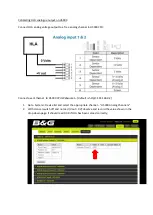
Introduction
8
NUAGE I/O (16D) / NUAGE I/O (16A) / NUAGE I/O (8A8D) Operation Manual
Precautions for Rack
Mounting
This unit is rated for operation at ambient temperatures
ranging from 0 to 40 degrees Celsius. When mounting the
unit with other device(s) in an EIA standard equipment
rack, internal temperatures can exceed the specified
upper limit, resulting in impaired performance or failure.
When rack mounting the unit, always observe the
following requirements to avoid heat buildup:
• When mounting the unit in a rack with devices such as
power amplifiers that generate a significant amount of
heat, leave more than 1U of space between NUAGE I/O
and other equipment. Also either leave the open spaces
uncovered or install appropriate ventilating panels to
minimize the possibility of heat buildup.
• To ensure sufficient airflow, leave the rear of the rack
open and position it at least 10 centimeters from walls or
other surfaces. If the rear of the rack can’t be left open,
install a commercially available fan or similar ventilating
option to secure sufficient airflow. If you’ve installed a
fan kit, there may be cases in which closing the rear of
the rack will produce a greater cooling effect. Refer to
the rack and/or fan unit manual for details.
Connection between the
Device and a Computer
The device can be connected to a computer in one of two
ways: with or without the DANTE ACCELERATOR. Using
the DANTE ACCELERATOR gives you the added
advantages of lower latency, using more channels, and
utilization of a redundant network. The descriptions in this
manual assume you are using the DANTE
ACCELERATOR.
To connect the device and a computer with the DANTE
ACCELERATOR, install the Dante Controller to the
computer. Dante Controller is a software application that
allows configuration and audio routing of the Dante
network.
When not using the DANTE ACCELERATOR, install the
Dante Controller and DVS (Dante Virtual Soundcard).
Dante Controller is a software application that allows
configuration and audio routing of the Dante network. DVS
is a software application that uses the computer as a
Dante-enabled device.
Dante Controller is available on the following website.
http://www.yamahaproaudio.com/
DVS is commercially available on the following website.
http://www.audinate.com/
For details on Dante Controller and DVS, refer to the
respective manuals.
How to Read the Manual
Conventions
• Brackets and quotation marks
Brackets ([ ]) and quotation marks (“ ”) around names and
phrases in this manual are used to indicate the following.
• Windows or Mac
When the procedures or explanations are specific to only
one of the platforms, Windows or Mac, this is properly
indicated in the manual. When the platforms do not
appear, procedures or explanations are for both Windows
and Mac.
• Procedures
“
” appears on some procedures in the manual. For
example, the string “Devices”
“Device Setup”
“Control Panel” indicates that you should perform the
procedures in the following order.
1.
Click the “Devices” menu.
2.
Select the “Device Setup” option.
3.
Click the “Control Panel” button.
• Keyboard Shortcuts
[Windows modifier key]/[Mac modifier key]+[key] shows
the shortcut keys. For example, [Ctrl]/[c[Z]
means “press [Ctrl] under Windows or [command] under
Mac, then press [Z].”
• Screens
This manual predominantly uses screenshots of Windows.
However, Mac screenshots are used when instructions of
the function apply only to the Mac. Also, this manual uses
screenshots of Nuendo 6. If you are using another version
of Nuendo, the actual screenshots might not be the same.
For details, refer to the Nuendo manuals (PDF) opened
from the “Help” menu.
Nuendo References
For brevity, the descriptions of Nuendo functions in this
manual have been kept simple and basic. For details on
Nuendo functions, refer to the Nuendo manuals (PDF)
opened from the “Help” menu.
Mark
Indication target
[ ]
• Buttons, switches, indicators, terminals, etc. on the
device.
• Keys on a computer keyboard.
“ ”
• Menus, buttons, tabs, areas, windows, etc. on a
computer window or software window.
• Excerpts of messages, function names, terms in
the manual, etc.









































